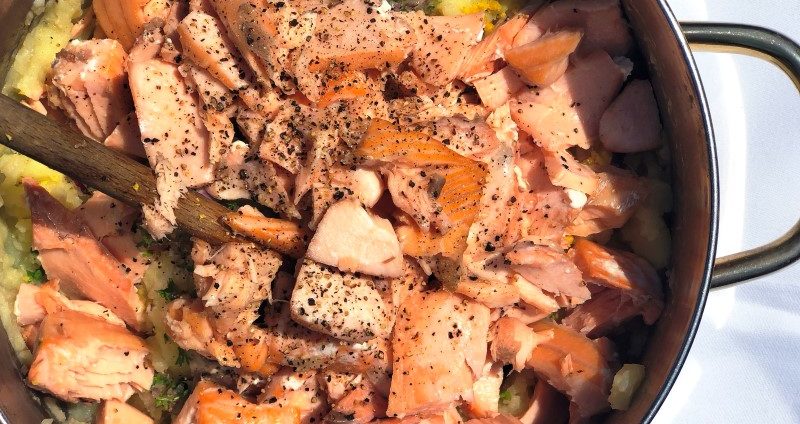Salmon Fishcakes

Serves 4
Ingredients:
500-600 grams of lightly smoked salmon fillets
700 grams of waxy, white potatoes
1/2 red onion – finely chopped
28 grams (or 1/2 packet) of fresh, flat leaf parsley – chopped
2 tablespoonfuls of plain flour
1 egg beaten
150 grams fresh breadcrumbs (you can use pre-prepared for convenience)
400mls of olive or vegetable oil for frying
small amount of dill, cut with a scissors
100 grams of garlic mayonnaise or natural yoghurt with pureed garlic
salad leaves and lemon wedges to serve
Method:
Preheat the oven to 200 degrees/fan 180 degrees/Gas Mark 6. Place the fish on a lightly greased baking tray or dish. Bake for 10-12 minutes or until just cooked through. Flake gently, removing any bones and leave to cool.
Cook the potatoes in a large pan of cold water and bring to the boil for approximately 15 minutes. Drain and mash with olive oil spread and a dash of milk. Cool slightly.
In a large bowl mix the mash, onion, lemon zest and parsley. Season well with freshly ground pepper and salt. Stir in the salmon, without breaking it up too much. Shape into 8 rounds, I find using a pastry cutter very helpful for this. Place on a baking tray lined with baking parchment paper and chill in the freezer for 30 minutes.
Tip the flour, egg and breadcrumbs into 3 separate bowls. Coat the fishcakes in flour, shaking off the excess. Dip in the egg, then the breadcrumbs, coating well. Having someone help you at this stage, will speed up the process as the fish cakes can lose their shape quite quickly when placed in the egg.

Heat the oil in a deep pan. Fry the fishcakes in batches for 2-3 minutes, until lightly golden. Remove with a slotted spoon and place on a baking tray.
Bake in the oven for 10-15 minutes, until piping hot.
Mix the dill into the garlic mayonnaise or natural yoghurt.
Serve the fish cakes with mayonnaise or garlic yoghurt, salad leaves and lemon wedges.

Nutritional highlights:
Salmon is an oily fish and packed full of omega 3 fatty acids, notably EPA and DHA. It is also an excellent source of Vitamin D, protein, some B vitamins and selenium.
Studies have found eating oily fish can lower blood pressure and reduce fat build-up in the arteries. The evidence is strong enough to warrant a government recommendation that we eat at least two portions of fish a week, one of which should be oily.
Fish stocks are declining for some species, for example wild salmon and trout, so aim to choose fish from sustainable sources where possible. You can do this by looking for Marine Stewardship Council (MSC) certified products, or consulting The Good Fish Guide from the Marine Conservation Society.
- Category: Mains
Ingredients
Instructions
0 Comment
Leave a Reply